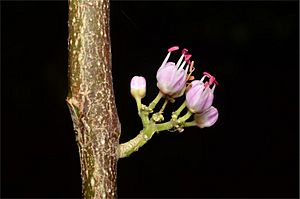Pink flowered doughwood facts for kids
Quick facts for kids Pink-flowered doughwood |
|
|---|---|
 |
|
| In the Royal Botanic Garden, Sydney | |
| Scientific classification | |
| Genus: |
Melicope
|
| Species: |
elleryana
|
| Synonyms | |
|
List
|
|
The Melicope elleryana, often called pink-flowered doughwood, pink evodia, corkwood, or saruwa, is a type of plant. It can be a shrub or a tree found in rainforests. This plant belongs to the Rutaceae family, which also includes citrus fruits. It grows naturally in New Guinea, parts of eastern Indonesia, the Solomon Islands, and northern Australia.
This plant has leaves made of three smaller leaflets, called trifoliate leaves. Its flowers are pink to white and can produce both male and female parts (bisexual). These flowers grow in clusters called panicles where the leaves meet the stem.
Contents
What Does the Pink-Flowered Doughwood Look Like?
The pink-flowered doughwood can grow quite tall, usually between 18 and 25 meters (about 60 to 82 feet). Its trunk can be around 60 centimeters (about 2 feet) wide. The bark is light brown and feels like cork, especially near the bottom of the tree.
Its leaves grow in pairs on opposite sides of the stem. Each leaf has a stalk, called a petiole, that is 20 to 110 mm long. The three leaflets are usually oval-shaped, 55 to 200 mm long and 35 to 80 mm wide. The leaflet at the end has its own small stalk, 5 to 17 mm long.
Flowers and Fruit
The flowers are bisexual, meaning they have both male and female parts. They grow in clusters that are 25 to 60 mm long. The small green parts at the base of the flower, called sepals, are round or egg-shaped and about 1.3 to 2 mm long. The petals are pink or white and measure 3.5 to 6.5 mm long. Each flower has four stamens, which are the parts that produce pollen.
This tree usually flowers from November to February. After flowering, it produces fruit. The fruit is made of up to four small pods, called follicles, which are 5 to 8 mm long. Inside these pods are shiny black seeds, each about 2 to 3 mm wide.
How the Pink-Flowered Doughwood Got Its Name
The pink-flowered doughwood was first officially described in 1865 by a scientist named Ferdinand von Mueller. He first named it Euodia elleryana. He wrote about it in a scientific book called Fragmenta phytographiae Australiae. He studied samples collected by Anthelme Thozet near Beddome Creek in Australia.
Later, in 1990, another scientist, Thomas Gordon Hartley, changed its name to Melicope elleryana. This new name was published in a journal called Telopea. The second part of its scientific name, elleryana, honors Robert L. J. Ellery. He was an important government astronomer in Victoria, Australia.
Where Does the Pink-Flowered Doughwood Grow?
This tree grows in different types of forests, including coastal forests, woodlands, and rainforests. It can be found from sea level up to an altitude of 760 meters (about 2,500 feet).
You can find Melicope elleryana in many places. It grows from the Maluku Islands in the east to the Solomon Islands, and south to New Guinea and northern Australia. In Australia, it is found in the far north-east of Western Australia, the Top End of the Northern Territory, and across northern and eastern Queensland. It also grows as far south as the Clarence River in northern New South Wales.
Life Cycle and Importance to Animals
The pink-flowered doughwood is a very important plant for the Ulysses butterfly (scientific name: Papilio ulysses). This tree is the main food source for the butterfly's caterpillars.
Growing new trees from seeds can be tricky. The seeds don't always sprout at the same time; some might start growing within 30 days, while others might take several years. If you soak the seeds in water for a few days, it seems to help them sprout more easily. This might remove things that stop them from growing.
How People Use the Pink-Flowered Doughwood
This tree is often planted in gardens and parks because it's very pretty. People like it as an ornamental tree.
In New Guinea, people use this tree in interesting ways. It is said that parts of the tree are used to add flavor to palm wine. Also, a sticky liquid that comes out of the bark is used as a glue. This sticky substance is also used to seal cracks in canoes and to help treat wounds.


